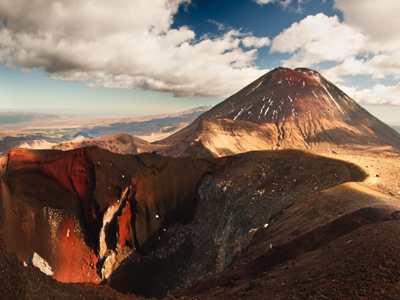
Ask the AI Tutor
Need help with Earthquakes and Volcanoes 03? Ask our AI Tutor!
AI Tutor - Lucy
Connecting with Tutor...
Please wait while we establish connection

Test yourself on earthquakes and volcanoes.
Earthquakes and Volcanoes 03
Plate boundaries are restless zones where the Earth's crust moves, melts and erupts. This KS3 Geography quiz explores earthquakes, volcanoes and dramatic plate collisions.
1 .
Which volcanoes are formed from runny lava and have gently sloping sides?
Ash volcanoes
Composite volcanoes
Dome volcanoes
Shield volcanoes
Mauna Loa in Hawaii is an excellent example
2 .
Earthquakes on the seabed can cause what?
Origamis
Toonarmies
Tsunamis
Typhoons
They are huge tidal waves - tsunami means 'harbour wave' in Japanese
3 .
What is the underground point where an earthquake starts?
Focus
Genesis
Hub
Origin
The seismic waves travel outwards from the focus in all directions. That is why it is possible to detect an earthquake that has happened on the other side of the world
4 .
An earthquake sends out what type of waves?
Ascorbic
Pelagic
Seismic
Semitic
Seismic is Greek for 'shake'
5 .
The volcano that erupted in Washington state in 1980 was Mount what?
St Helens
St James
St Neots
St Swithins
It was a huge eruption - the mountain literally blew its top. After the eruption had stopped, the mountain was 400 m lower and had a crater at the top that was 2 - 3 km wide and about 700 m deep
6 .
What word describes the plates of the earth's crust?
Platonic
Subsonic
Technotronic
Tectonic
Movement of plates causes 'quakes and eruptions
7 .
Which is not a type of plate boundary?
Conservative
Constructive
Destructive
Distinctive
You don't usually get volcanoes at conservative plate boundaries
8 .
Where the edges of plates meet is called what?
Plate boundary
Plate border
Plate junction
Plate seam
Also known as a plate margin
9 .
Volcanoes that have erupted recently are called what?
Active
Alert
Effervescent
Vibrant
The closest active volcanoes to the UK are in Italy and in Iceland
10 .
What kind of volcanic 'flow' includes hot gas, ash and lava?
Hypocaustic
Panasonic
Pyroclastic
Pyrotechnic
A cloud of hot ash from an eruption of Mount Vesuvius in AD79 destroyed the town of Pompeii. The ash was so fine that the bodies of the victims were very well preserved
**Unlimited Quizzes Await You! 🚀**
Hey there, quiz champ! 🌟 You've already tackled today's free questions.
Ready for more?
Ready for more?
🔓 Unlock UNLIMITED Quizzes and challenge yourself every day. But that's
not all...
not all...
🔥 As a Subscriber you can join our thrilling "Daily Streak" against other
quizzers. Try to win a coveted spot on our Hall of Fame Page.
quizzers. Try to win a coveted spot on our Hall of Fame Page.
Don't miss out! Join us now and keep the fun rolling. 🎉
**Unlimited Quizzes Await You! 🚀**
Hey there, quiz champ! 🌟 You've already tackled today's free questions. Ready for more?
🔓 Unlock UNLIMITED Quizzes and challenge yourself every day. But that's not all...
🔥 As a Subscriber you can join our thrilling "Daily Streak" against other quizzers. Try to win a coveted spot on our Hall of Fame Page.
Don't miss out! Join us now and keep the fun rolling. 🎉






